Some NVAR Households Could Face Limited Choices
About 93,500 households moved in the NVAR region each year between 2012 and 2014, or about 16 percent of all households in the region. That area includes Alexandria City, Arlington County, Fairfax County, Fairfax City and Falls Church City.
On average, 21,000 mover households bought a home, driving the home sales market. The type of unit that these movers purchased was guided, in part, by the household composition of the buyers. Preferences differ among households with children, households without children and single buyers.
WHERE ARE HOUSEHOLDS MOVING TO AND FROM?
About one household out of every five in Alexandria and Arlington moved in the prior year during the 2012 to 2014 timeframe (the mobility rate). The mobility rate for households in Fairfax County, Fairfax City and Falls Church City combined, was significantly lower at 13.8 percent, but there was considerable variation within this area, as shown in Figure 1. Of the identified geographies, the highest mobility rate was in south Arlington at 23.1 percent, and the lowest was 11.3 percent in the area stretching from Fairfax City to Springfield in Fairfax.
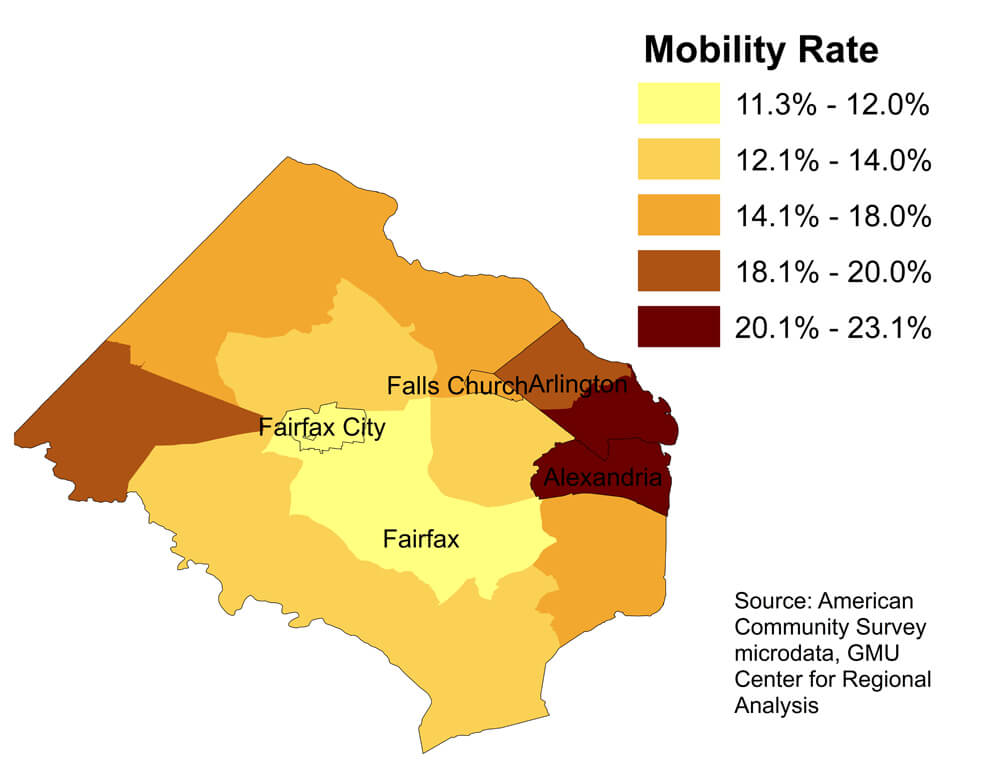
More than half (56.2 percent) of the movers in the area moved within the NVAR region. The majority of these moves occurred within the same jurisdiction, with only about one quarter of these households moving across jurisdictions. Over one third (35.5 percent) of the movers came from elsewhere in the United States. Not surprisingly, about 44 percent of domestic movers from outside of the NVAR region moved from Virginia, Maryland or the District. The remaining 8.3 percent moved to the region from abroad. Table 1 shows the average annual households by move status for the available jurisdictions or groups of jurisdictions for the 2012-2014 timeframe.
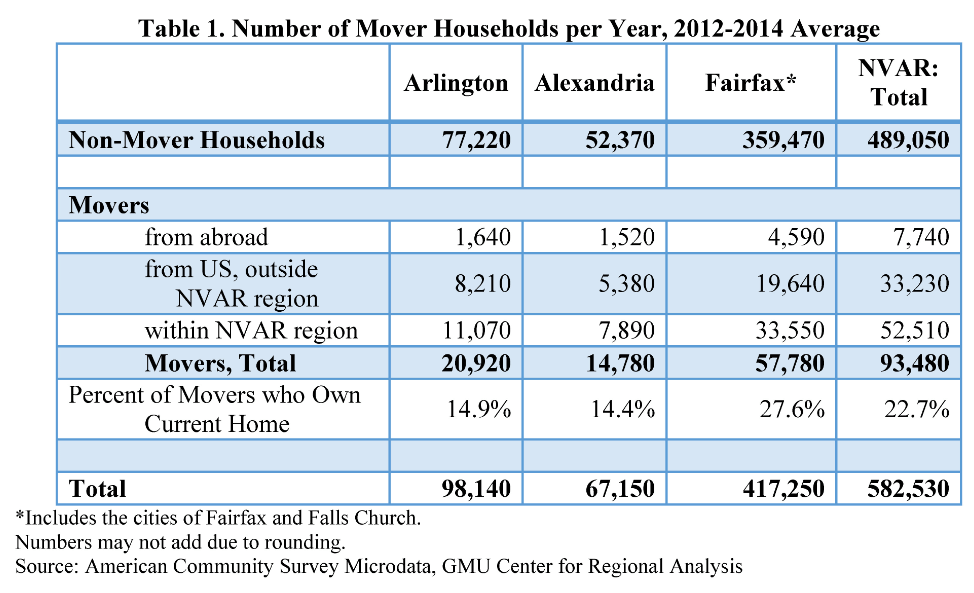
WHO IS BUYING?
After moving, 22.7 percent of mover households were owners. The households that moved into owner-occupied units are assumed to have been recent buyers. There are exceptions, including those who inherited the properties or made the purchase years before moving. Nevertheless, these exceptions should not significantly alter the emerging patterns.
Among all movers, those who moved to Fairfax County, Fairfax City and Falls Church City, combined, were more likely to buy than movers in Arlington and Alexandria. Households already in the NVAR region were also more likely to buy (Figure 2). But movers from elsewhere in the US were less likely to buy than movers from abroad.
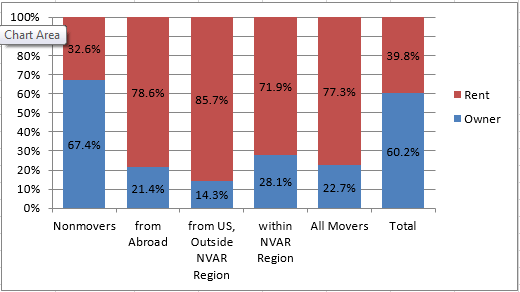
Movers tend to be younger, and recent buyers were far more likely to be under 35 years old than non-mover owners. Families with children were also more likely to be movers, and 36.8 percent of all recent buyers in the NVAR region had children, compared to just 33.7 percent for non-mover owners. On the other end of the spectrum, recent buyers were also more likely to be living alone than non-mover owners (27.2 percent vs. 22.6 percent).
Overall, buyers in the NVAR region fell into one of three broad household types with distinct housing preferences:
1. Families with one or more children (36.8 percent of buyers)
2. Couples and roommates without kids (36.0 percent)
3. Single people living alone (27.2 percent).
FAMILIES WITH ONE OR MORE CHILDREN
The largest household type of buyers in the NVAR region was families with at least one child. About 44.1 percent of these families had one child, and these families tended to be younger, with an average householder age of 37. A slightly smaller share (41.2 percent) had two children, and 14.7 percent had three or more children. The average age of the householder for families with two or more children was 41.
As shown in Figure 3, these families overwhelmingly bought in Fairfax County, Fairfax City or Falls Church City. They also were most likely to buy four-plus bedroom, single-family detached (SFD) homes.
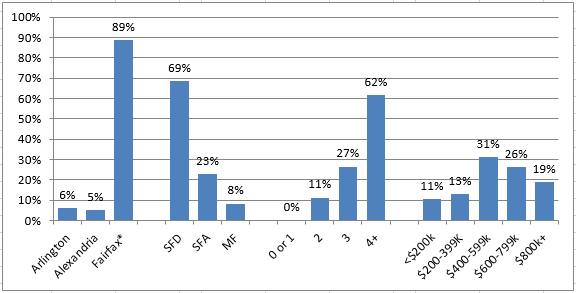
Nearly one third (31.1 percent) of the homes they bought were valued between $400,000 and $600,000. But almost half (45.2 percent) valued their homes at more than $600,000, including 19.0 percent valued at over $800,000. Of all household types, families with at least one child were more likely to buy units at these price points.
*Includes the cities of Fairfax and Falls Church.
Source: American Community Survey Microdata, GMU Center for Regional Analysis
FAMILIES AND ROOMMATES WITHOUT KIDS
Buyers who were married couples, other families and roommates without kids, accounted for 36.0 percent of all buyers in the NVAR region during the 2012-2014 period. Buyers in this group were predominately between 25 and 34 years old, with 41.4 percent of householders in this age range.
Similar to households with children, the vast majority bought in Fairfax County, Fairfax City or Falls Church City. While the plurality bought single-family detached homes, a large share (40.2 percent) purchased single-family attached (SFA) homes.
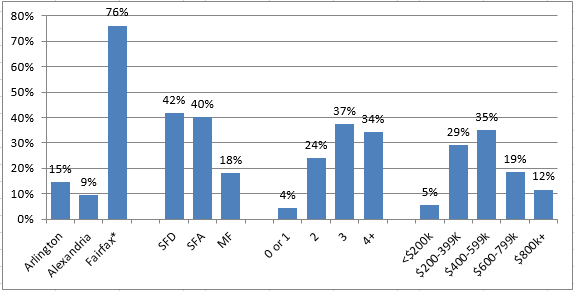
Households without children also were more likely to buy three-bedroom homes, and the price points were moderately lower.
*Includes the cities of Fairfax and Falls Church.
Source: American Community Survey Microdata, GMU Center for Regional Analysis
SINGLE PEOPLE LIVING ALONE
Over one quarter (27.2 percent) of all buyers in the NVAR region were single and living alone during the 2012-2014 timeframe. Notably, female buyers accounted for 58.6 percent of single buyers. Both male and female buyers had a similar age distribution, with buyers clustering in the 25 to 44 age range as well as in the 55 to 59 age group.
“While inventory continues to increase, it will remain tight for some of the units favored by households without children: single-family attached homes and for three-bedroom homes."
While the majority of singles bought in Fairfax County, Fairfax City or Falls Church City, this buyer group was also well represented in Arlington and Alexandria.
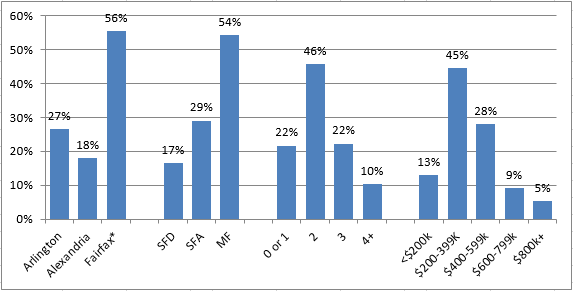
These buyers were also more likely to purchase in multi-family (MF) buildings, and 54.4 percent did so. It is no surprise that these units were smaller, and nearly half (45.7 percent) were two bedroom units. These units also had lower home values, with the majority (57.5 percent) valued at less than $400,000.
*Includes the cities of Fairfax and Falls Church.
Source: American Community Survey Microdata, GMU Center for Regional Analysis
OUTLOOK
These broad household types reveal variations in home preferences, many of which are intuitive. Families with children desire larger units in single-family detached homes, while singles often prefer more urban, smaller units in multi-family buildings. Households (non-singles) without children fall somewhere in between and are more likely to be in mid-size, single-family attached units.
Based on these preferences, households without children may have difficulty finding units going forward. While inventory continues to increase, it will remain tight for some of the units favored by households without children: single-family attached homes and for three-bedroom homes. Additionally, low inventory for homes priced in the $400,000 to $600,000 range will make the home search more difficult for these households, but will affect all buyer types significantly.